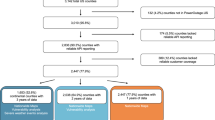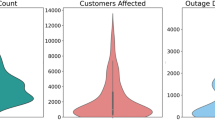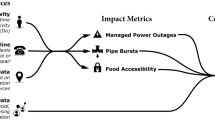Abstract
Background
Precipitated by an unusual winter storm, the 2021 Texas Power Crisis lasted February 10 to 27 leaving millions of customers without power. Such large-scale outages can have severe health consequences, especially among vulnerable subpopulations such as those reliant on electricity to power medical equipment, but limited studies have evaluated sociodemographic disparities associated with outages.
Objective
To characterize the 2021 Texas Power Crisis in relation to distribution, duration, preparedness, and issues of environmental justice.
Methods
We used hourly Texas-wide county-level power outage data to estimate geographic clustering and association between outage exposure (distribution and duration) and six measures of racial, social, political, and/or medical vulnerability: Black and Hispanic populations, the Centers for Disease Control and Prevention (CDC) Social Vulnerability Index (SVI), Medicare electricity-dependent durable medical equipment (DME) usage, nursing homes, and hospitals. To examine individual-level experience and preparedness, we used a preexisting and non-representative internet survey.
Results
At the peak of the Texas Power Crisis, nearly 1/3 of customers statewide (N = 4,011,776 households/businesses) lost power. We identified multiple counties that faced a dual burden of racial/social/medical vulnerability and power outage exposure, after accounting for multiple comparisons. County-level spatial analyses indicated that counties where more Hispanic residents resided tended to endure more severe outages (OR = 1.16, 95% CI: 1.02, 1.40). We did not observe socioeconomic or medical disparities. With individual-level survey data among 1038 respondents, we found that Black respondents were more likely to report outages lasting 24+ hours and that younger individuals and those with lower educational attainment were less likely to be prepared for outages.
Significance
Power outages can be deadly, and medically vulnerable, socioeconomically vulnerable, and marginalized groups may be disproportionately impacted or less prepared. Climate and energy policy must equitably address power outages, future grid improvements, and disaster preparedness and management.
This is a preview of subscription content, access via your institution
Access options
Subscribe to this journal
Receive 6 print issues and online access
$259.00 per year
only $43.17 per issue
Buy this article
- Purchase on Springer Link
- Instant access to full article PDF
Prices may be subject to local taxes which are calculated during checkout


Similar content being viewed by others
Data availability
The final dataset used in the county-level analysis including customers without power, customers served, and the demographic information is available on GitHub (https://github.com/nina-flores/texas-po-dta). The code used for county-level analyses are also available. Individual-level data from analyses may be available following IRB approval.
References
Busby JW, Baker K, Bazilian MD, Gilbert AQ, Grubert E, Rai V, et al. Cascading risks: understanding the 2021 winter blackout in Texas. Energy Res Soc Sci. 2021;77:102106.
Texas Department of State Health Services. Winter storm-related deaths: Texas Department of State Health Services. 2021. https://dshs.texas.gov/news/updates.shtm.
Aldhous P, Lee SM, Hirji Z. The texas winter storm and power outages killed hundreds more people than the state says: BuzzFeed News. 2021. https://www.buzzfeednews.com/article/peteraldhous/texas-winter-storm-power-outage-death-toll.
Cohen J, Pfeiffer K, Francis JA. Warm Arctic episodes linked with increased frequency of extreme winter weather in the United States. Nat Commun. 2018;9:869.
Casey JA, Fukurai M, Hernández D, Balsari S, Kiang MV. Power outages and community health: a narrative review. Curr Environ Health Rep. 2020;7:371–83.
Molinari NAM, Chen B, Krishna N, Morris T. Who’s at risk when the power goes out? The at-home electricity-dependent population in the United States, 2012. J Public Health Manag Pr. 2017;23:152–9.
Smith GS, Anjum E, Francis C, Deanes L, Acey C. Climate change, environmental disasters, and health inequities: the underlying role of structural inequalities. Curr Environ Health Rep. 2022;9:80–9.
Chakraborty J, McAfee AA, Collins TW, Grineski SE. Exposure to Hurricane Harvey flooding for subsidized housing residents of Harris County, Texas. Nat Hazards. 2021;106:2185–205.
Mitsova D, Esnard A-M, Sapat A, Lai BS. Socioeconomic vulnerability and electric power restoration timelines in Florida: the case of Hurricane Irma. Nat Hazards. 2018;94:689–709.
Maliszewski PJ, Larson EK, Perrings C. Environmental determinants of unscheduled residential outages in the electrical power distribution of Phoenix, Arizona. Reliab Eng Syst Saf. 2012;99:161–71.
Liévanos RS, Horne C. Unequal resilience: the duration of electricity outages. Energy Policy. 2017;108:201–11.
Román MO, Stokes EC, Shrestha R, Wang Z, Schultz L, Carlo EAS, et al. Satellite-based assessment of electricity restoration efforts in Puerto Rico after Hurricane Maria. PLoS ONE. 2019;14:e0218883.
Dvorkin Y. How to Prevent a Power Outage From Becoming a Crisis: @. 2021. https://spectrum.ieee.org/prevent-power-outage-crisis.
Carvallo J, Hsu FC, Shah Z, Taneja J. Frozen out in Texas: blackouts and inequity—The Rockefeller Foundation. The Rockefeller Foundation; 2021. https://www.rockefellerfoundation.org/case-study/frozen-out-in-texas-blackouts-and-inequity/.
Garnham AU, Juan P. Already hit hard by pandemic, Black and Hispanic communities suffer the blows of an unforgiving winter storm. 2021.
Baker S, DeVar S, Prakash S. Section 1—Defining Energy Justice: Connections to Environmental Justice, Climate Justice, and the Just Transition—Initiative for Energy Justice. 2019.
Gonzalez DJX, Nardone A, Nguyen AV, Morello-Frosch R, Casey JA. Historic redlining and the siting of oil and gas wells in the United States. J Expo Sci Environ Epidemiol. 2022:1–8.
Lewis J, Hernández D, Geronimus AT. Energy efficiency as energy justice: addressing racial inequities through investments in people and places. Energy Efficiency. 2020;13:419–32.
Hernández D. Understanding ‘energy insecurity’ and why it matters to health. Soc Sci Med. 2016;167:1–10.
Jessel S, Sawyer S, Hernández D. Energy, poverty, and health in climate change: a comprehensive review of an emerging literature. Front Public Health. 2019;7:1–16.
“Maps.” Electric Reliability Council of Texas (ERCOT). 2021. http://www.ercot.com/news/mediakit/maps.
Galbraith K. Texplainer: why does Texas have its own power grid? 2011.
Dominianni C, Lane K, Johnson S, Ito K, Matte T. Health impacts of citywide and localized power outages in New York City. Environ Health Perspect. 2018;126:067003.
Mukherjee S, Nateghi R, Hastak M. A multi-hazard approach to assess severe weather-induced major power outage risks in the US. Reliab Eng Syst Saf. 2018;175:283–305.
Zhang W, Sheridan S, Birkhead G, Croft D, Brotzge J, Justino J, et al. Power outage: an ignored risk factor for chronic obstructive pulmonary disease exacerbations. Chest. 2020;158:2346–57.
Project 40296. Public Utility Commission of Texas. 2012.
HHS emPOWER Program. 2021. https://empowerprogram.hhs.gov/about-empowermap.html.
CDC/ATSDR Social Vulnerability Index: Centers for Disease Control and Prevention/Agency for Toxic Substances and Disease Registry/Geospatial Research, Analysis, and Services Program. 2018. https://www.atsdr.cdc.gov/placeandhealth/svi/data_documentation_download.html.
Manson S, Schroeder J, Van Riper D, Kugler T, Ruggles S. IPUMS National Historical Geographic Information System: Version 16.0 [dataset]. Minneapolis, MN: IPUMS; 2021. https://doi.org/10.18128/D050.V16.0.
Texas Health and Human Services. Nursing Facilities (NF). Texas Health and Human Services. 2021. https://www.hhs.texas.gov/doing-business-hhs/provider-portals/long-term-care-providers/nursing-facilities-nf.
Texas Health and Human Services. Hospitals—Directory of General and Special Hospitals. Texas Health and Human Services. 2021. https://www.hhs.texas.gov/doing-business-hhs/provider-portals/health-care-facilities-regulation/hospitals-general-hospitals.
Li X, Anselin L. rgeoda: R Library for Spatial Data Analysis. 2022. https://github.com/geodacenter/rgeoda/, https://geodacenter.github.io/rgeoda/.
Korthauer K, Kimes PK, Duvallet C, Reyes A, Subramanian A, Teng M, et al. A practical guide to methods controlling false discoveries in computational biology. Genome Biol. 2019;20:118.
Caragea PC, Kaiser MS. Autologistic models with interpretable parameters. J Agric Biol Environ Stat. 2009;14:281.
Besag JE. Nearest-neighbour systems and the auto-logistic model for binary data. J R Stat Soc Series B Methodol. 1972;34:75–83. http://www.jstor.org/stable/2985051.
Ingram DD, Franco SJ. NCHS urban–rural classification scheme for counties. National Center for Health Statistics. Vital Health Stat 2. 2014;166:1–5.
Elser H, Goldman-Mellor S, Morello-Frosch R, Deziel NC, Ranjbar K, Casey JA. Petro-riskscapes and environmental distress in West Texas: community perceptions of environmental degradation, threats, and loss. Energy Res Soc Sci. 2020;70:101798.
Kessler RC, Barker PR, Colpe LJ, Epstein JF, Gfroerer JC, Hiripi E, et al. Screening for serious mental illness in the general population. Arch Gen Psychiatry. 2003;60:184–9.
Bolker BM, Brooks ME, Clark CJ, Geange SW, Poulsen JR, Stevens MHH, et al. Generalized linear mixed models: a practical guide for ecology and evolution. Trends Ecol Evolution. 2009;24:127–35.
Juarez S. El Paso Heeded the Warnings and Avoided a Winter Catastrophe. TexasMonthly. 2021.
Maliszewski PJ, Perrings C. Factors in the resilience of electrical power distribution infrastructures. Appl Geogr. 2012;32:668–79.
PUC T. 25.497—Critical Load Industrial Customers, Critical Load Public Safety Customers, Critical Care Residential Customers, and Chronic Condition Residential Customers. Public Utility Commission of Texas. 2018.
Coleman N, Esmalian A, Mostafavi A. Equitable resilience in infrastructure systems: empirical assessment of disparities in hardship experiences of vulnerable populations during service disruptions. Nat Hazards Rev. 2020;21:04020034.
EPA. Climate change and social vulnerability in the United States: a focus on six impacts. U.S. Environmental Protection Agency, EPA 430-R-21-003. 2021.
Dominianni C, Ahmed M, Johnson S, Blum M, Ito K, Lane K. Power outage preparedness and concern among vulnerable New York City residents. J Urban Health. 2018;95:716–26.
Cox K, Kim B. Race and income disparities in disaster preparedness in old age. J Gerontol Soc Work. 2018;61:719–34.
Keisler-Starkey K, Bunch LN. Health insurance coverage in the United States. 2020.
Sakashita K, Matthews WJ, Yamamoto LG. Disaster preparedness for technology and electricity-dependent children and youth with special health care needs. Clin Pediatrics. 2013;52:549–56.
Zidek C, West E, Holmes J, Crytzer M. A survey comparison of rural versus urban residents and household preparedness. Home Healthcare Now. 2014;32:420–9.
Casey JA, Mango M, Mullendore S, Kiang MV, Hernández D, Li BH, et al. Trends from 2008 to 2018 in electricity-dependent durable medical equipment rentals and sociodemographic disparities. Epidemiology. 2021;32:327–35.
IPCC. Climate Change 2021: the physical science basis. Contribution of Working Group I to the Sixth Assessment Report of the Intergovernmental Panel on Climate Change. In: Masson-Delmotte V, Zhai P, Pirani A, Connors SL, Péan C, Berger S, et al. editors. Cambridge University Press. In Press. 2021.
Pressler M. Texas Electricity in 2021. 2021.
American Society of Civil Engineers. 2021 report card for America’s infrastructure: funding and future need. 2021.
Acknowledgements
We would like to thank all research participants.
Funding
This work was supported by the National Institute of Environmental Health Sciences P30ES009089 grant and the T32ES007322-21 training grant.
Author information
Authors and Affiliations
Contributions
JAC, MVK, and NMF conceptualized the study. HM, VD, and NMF curated the power outage dataset. JAC implemented the survey. NMF analyzed the data and wrote the article. All authors critically revised the article.
Corresponding author
Ethics declarations
Competing interests
The authors declare no competing interests.
Ethical approval
The Columbia University Institutional Review Board approved this study.
Additional information
Publisher’s note Springer Nature remains neutral with regard to jurisdictional claims in published maps and institutional affiliations.
Supplementary information
Rights and permissions
Springer Nature or its licensor holds exclusive rights to this article under a publishing agreement with the author(s) or other rightsholder(s); author self-archiving of the accepted manuscript version of this article is solely governed by the terms of such publishing agreement and applicable law.
About this article
Cite this article
Flores, N.M., McBrien, H., Do, V. et al. The 2021 Texas Power Crisis: distribution, duration, and disparities. J Expo Sci Environ Epidemiol 33, 21–31 (2023). https://doi.org/10.1038/s41370-022-00462-5
Received:
Revised:
Accepted:
Published:
Issue Date:
DOI: https://doi.org/10.1038/s41370-022-00462-5
Keywords
This article is cited by
-
Assessing the household burdens of infrastructure disruptions in Texas during Winter Storm Uri
Natural Hazards (2024)
-
A data-driven approach to quantify disparities in power outages
Scientific Reports (2023)
-
Rising vulnerability of compound risk inequality to ageing and extreme heatwave exposure in global cities
npj Urban Sustainability (2023)



